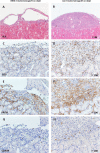Ex vivo Pretreatment of Islets with Mitomycin C: Reduction in Immunogenic Potential of Islets by Suppressing Secretion of Multiple Chemotactic Factors
- PMID: 28901184
- PMCID: PMC5680981
- DOI: 10.1177/0963689717721233
Ex vivo Pretreatment of Islets with Mitomycin C: Reduction in Immunogenic Potential of Islets by Suppressing Secretion of Multiple Chemotactic Factors
Abstract
Strategies to reduce the immunogenicity of pancreatic islets and to prevent the activation of proinflammatory events are essential for successful islet engraftment. Pretransplant islet culture presents an opportunity for preconditioning to improve outcomes of islet transplantation. We previously demonstrated that ex vivo mitomycin C (MMC) pretreatment and subsequent culture significantly prolonged graft survival. Fully understanding the biological process of pretreatment could result in the development of a protocol to improve the survival of islet grafts. Microarrays were employed to conduct a comprehensive analysis of genes expressed in untreated or MMC-treated rat islets that were subsequently cultured for 3 d. A bioinformatics software was used to identify biological processes that were most affected by MMC pretreatment, and validation studies, including in vivo and in vitro assay, were performed. The gene expression analysis identified significant downregulation of annotated functions associated with cellular movement and revealed significant downregulation of multiple genes encoding proinflammatory mediators with chemotactic activity. Validation studies revealed significantly decreased levels of interleukin 6 (IL-6), monocyte chemoattractant protein 3 (MCP-3), and matrix metallopeptidase 2 (MMP2) in culture supernatants of MMC-treated islets compared with controls. Moreover, we showed the suppression of leukocyte chemotactic activity of MMC-treated islets in vitro. We also showed that MMC-treated islets secreted lower levels of chemoattractants that synergistically reduced the immunogenic potential of islets. Histological and immunohistochemical analyses of the implant site revealed that infiltration of monocytes, CD3-positive T cells, and B cells was decreased in MMC-treated islets. In conclusion, the ex vivo pretreatment of islets with MMC and subsequent culture can reduce the immunogenic potential and prolong the survival of islet grafts by inducing the suppression of multiple leukocyte chemotactic factors.
Keywords: inflammation; islets transplantation; preconditioning; tolerance.
Conflict of interest statement
Figures








References
-
- Shapiro AM, Ricordi C, Hering BJ, Auchincloss H, Lindblad R, Robertson RP, Secchi A, Brendel MD, Berney T, Brennan DC, et al. International trial of the Edmonton protocol for islet transplantation. N Engl J Med. 2006;355(13):1318–1330. - PubMed
-
- Ryan EA, Paty BW, Senior PA, Bigam D, Alfadhli E, Kneteman NM, Lakey JR, Shapiro AM. Five-year follow-up after clinical islet transplantation. Diabetes. 2005;54(7):2060–2069. - PubMed
-
- Bennet W, Groth CG, Larsson R, Nilsson B, Korsgren O. Isolated human islets trigger an instant blood mediated inflammatory reaction: implications for intraportal islet transplantation as a treatment for patients with type 1 diabetes. Upsala J Med Sci. 2000;105(2):125–133. - PubMed
-
- Sleater M, Diamond AS, Gill RG. Islet allograft rejection by contact-dependent CD8+ T cells: perforin and FasL play alternate but obligatory roles. Am J Transplantat. 2007;7(8):1927–1933. - PubMed
Publication types
MeSH terms
Substances
LinkOut - more resources
Full Text Sources
Other Literature Sources
Miscellaneous

